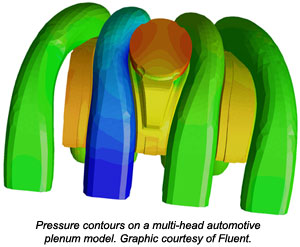Cfd Software Fluent

I've used Fluent for a while, mostly for designing solarcars. It is fairly easy to get started, given its complexity and power, but coaxing useful and valid results out of it takes time, experience and a good eye for meshing. It is absolutely essential when starting with Fluent to learn from someone who is experienced with the code and understands it well. Often this means taking lots of courses.
Attempting to learn it on your own will simply not happen in a few months; there are far too many nuances and potential problems that you simply wouldn't catch without help at first. Just to clarify here: FLUENT is a computational fluid dynamics program. It is designed to take a 2D or 3D CAD model, and simulate the fluid flow over/through that model. It does this by iteratively solving a set of partial differential equations, which are known to accurately represent fluid flow properties, over each of several thousand (or million, in some cases) simple 3D grid cells throughout the open space of the model.
SimuTech offers ANSYS Computational Fluid Dynamics (CFD) software including ANSYS CFD, ANSYS Fluent, ANSYS CFD Flo, ANSYS CFX, ANSYS Icepack and much more. Software Libraries. FLUENT is a commercial CFD program developped by Ansys Inc. The latest version is 13.0. About CFD-Wiki; Disclaimers.
Terrain Height Maps. When the iterative solution has converged, you are left with a set of numbers representing the fluid's velocity, pressure, temperature, etc. At each of those grid cells. If you set up the calculation correctly, the results can yield considerable insight into the actual behaviour of the fluid at any given point near the model. This is a substantial advantage over wind-tunnel or tank testing, where precise details of the flow are difficult or impossible to identify.
The drawback is that to get good, useful results and accurate force/pressure numbers, you need a lot of experience with the software and a good eye for flow patterns. It is quite easy to screw up in the early stages of preprocessing the CAD model (a very labour-intensive process) and end up with a mesh that yields inaccurate results.
It's just as easy to specify an incorrect relaxation factor somewhere, and send the results oscillating off to infinity after ten hours of computation. So in short, CFD codes can (almost) replace model testing, and are preferable in many respects, but require considerable skill and experience in order to be useful.
